The 2021 Ford Mustang Mach-E is The Blue Oval’s first-ever high-volume electric car and an important step in keeping Ford competitive as the entire industry shifts towards EVs. I just drove the Mach-E for the first time, and while I wouldn’t call it exciting, it’s a good electric crossover SUV.
(Full Disclosure: Ford invited me to the American Center for Mobility in Ypsilanti, Michigan. After arriving there in my $500 Jeep, Ford fed me chili and gave me a far-too-expensive gift that will be giving away to a reader soon.)
I think it’s safe to say that most of the reviews you’ll read about the Mach-E will start with this narrative: When the Mustang Mach-E debuted at the 2019 Los Angeles Auto Show, the world cried out in horror. Ford had decided to give the sacred name “Mustang” (which, you should all remember, also adorned the sheetmetal of some four-cylinder crap-cans in the 1970s) to an electric unibody SUV, and this, to many, was blasphemy.
“That’s not a real Mustang!” the purists cried. “I’m going to peel out of a Cars and Coffee and lose control!” they continued, clearly losing sight of their original point. “My V6 Mustang is faster than a Ferrari!” they went on, at this point having completely abandoned thinking about the electric SUV.
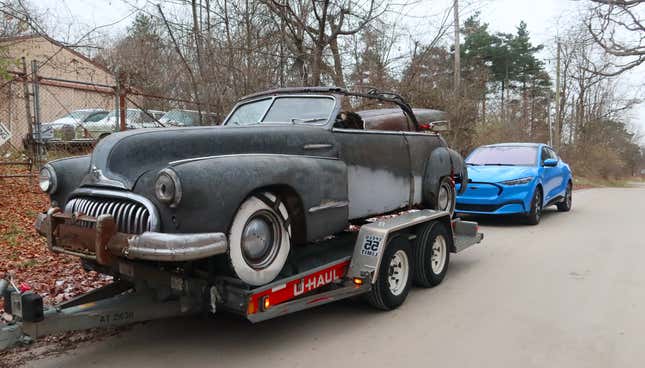
The Mustang bros’ original point is valid, though — the Ford Mustang Mach-E isn’t a “real Mustang” in that it’s not a sleek sports coupe with an available manual transmission and an awesome-sounding motor. The new electric car may share some styling cues with the coupe, but the reality is that it is very different.
Whether that matters depends on how much an automobile nameplate means to you. Ford itself admits that, even if some of the team that worked on the Mach-E also worked on the Mustang coupe, the name is really just a marketing move. After all, it’s hard to compete with a nameplate like “Tesla” with one that adorns the sheetmetal of a car as uncool as the EcoSport.
“Mustang,” though? Ford is hoping that name might be just the thing to get enthusiasts in a buying mood.
2021 Ford Mustang Mach-E: What You Need To Know
The Ford Mustang Mach-E is a rear-wheel drive or all-wheel drive all-electric crossover SUV that comes with either a 68 kWh “standard range” battery (this is the usable capacity) or an 88 kWh “extended range” unit. The pack, filled with LG pouch cells, sits between the axles and acts as a structural component that bolts into the chassis from underneath. It’s a common setup among EVs. There are two available motors, a 210 kW (282 horsepower), 300 lb-ft unit and a 40 kW (67 horsepower), 111 lb-ft motor.
The Mach-E can be configured to have only one large motor in the rear, one large motor in the rear and a small motor up front, or a large motor in both the front and rear. Power for the Mach-E lineup ranges from 266 to 480 HP, with torque output between 317 and 634 lb-ft. Official EPA range estimates fall between 211 miles for standard range all-wheel drive models and 300 miles for extended range rear-wheel drive cars.
Suspension is a MacPherson strut design in the front and a multilink setup in the rear, as is typical in the mid-size crossover space. Overall dimensions are just a bit smaller than those of a Ford Edge SUV, and pricing starts at around $43,000, jumping up to roughly $61,000 for the GT extended range all-wheel drive model. Pricing for the performance version hasn’t been announced, but we do know that among other differences it makes 34 more lb-ft of torque than the 600 lb-ft GT model and cuts its estimated 0-60 mph time from 3.8 to 3.5 seconds.
For a full breakdown of the Mach-E’s technical bits, see my interview with chief engineer Ron Heiser.
A Pleasant Cabin, A Firm But Decent Ride

Before jumping into a blue Mustang Mach-E labeled “E4X” (for extended range), I had a chance to use the car’s unique electric door latch button. To open the door, I grabbed the small, protruding handle — which sits at the intersection of the car’s beltline and B-pillar — with my middle and ring fingers, and used my index finger to poke a round button, which unlatched the door and shoved it open a few degrees.
It worked well, though I can’t think of another car door that requires such an odd hand position. While I suspect I’d get used to it after a while, I found the setup a little strange.

Once inside, I found myself surrounded by an understated cabin filled with black leather-ish material, plastic and glass. There was a huge 15.5-inch, vertically oriented screen in the center with a nice physical rotary dial for volume control, and a long cloth-covered sound bar at the top of the dash. It looks great up close.
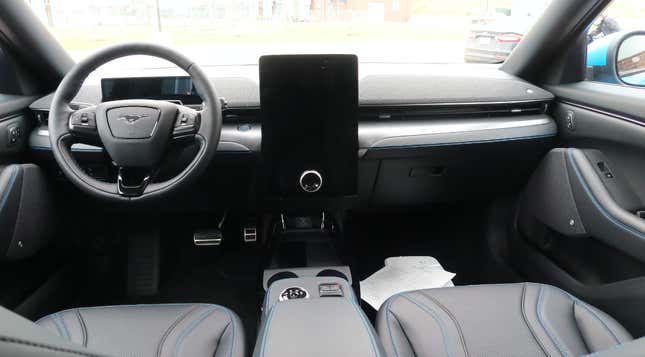
The seats are flat, communicating that this car is meant for comfort before agility, no matter how “sporty” that blue stitching might look.
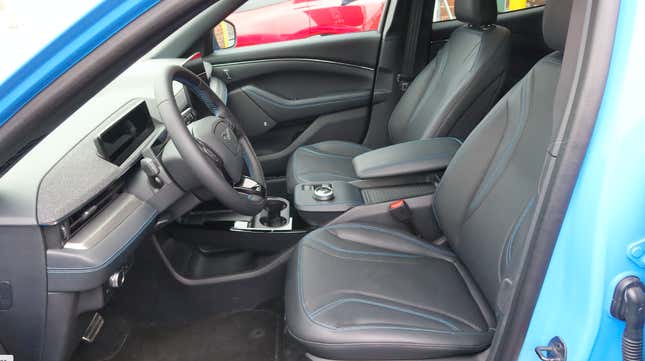
You’ll notice that Ford opted for a center console, even though there’s no transmission tunnel as there likely would if the MachE had a conventional internal-combustion engine. Chief engineer Ron Heiser told me that Ford’s research showed that, despite a lack of a transmission/exhaust tunnel, customers wanted a console to fill the space between the seats. That console includes a cubby under the armrest on the upper level, two cupholders and a wireless charging pad on the middle level, and a large storage area on the lowest level just to the right of the driver’s legs.
Just ahead of the cubby, under the armrest is the rotary gear selector labeled “PRND” with a button in the center that reads “L” for low. As I understand it that button selects a mode that uses the electric motor’s regenerative brake capability to simulate a low gear on a conventional car with a multispeed transmission. Off to the right of the dial is an electronic parking brake, a button to activate and deactivate lane keep assist, and the car’s hazard light switch.

It’s a nice, simple setup and it’s intuitive to use.

Once on the streets, I noticed that the ride is a bit firm, communicating quite a few road imperfections into the body of the car. There’s also plenty of road noise, though I suspect that’s made more noticeable by the fact that powertrain noise and wind noise are all but nonexistent.

Thanks to a low hood that doesn’t have to contain an internal combustion engine, forward visibility is good. It’s nice to have the slim screen shown above not far from your natural line-of-sight, just behind the steering wheel. In the Tesla Model Y, drivers look to the center screen for vehicle information; I strongly prefer Ford’s setup.
Rearward visibility is decent thanks to the backup camera, though the image is hardly the sharpest I’ve seen:
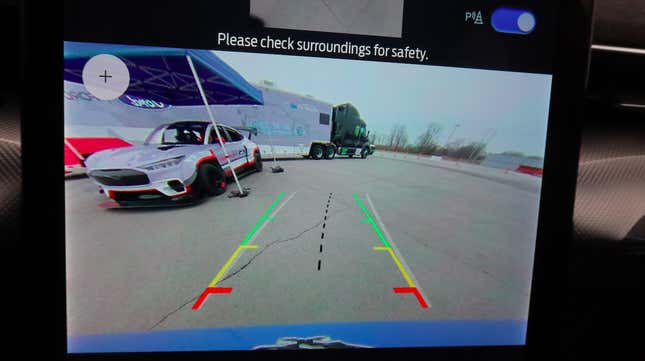
Overall, the cabin is basic, but comfortable and, again, intuitive.
Acceleration And Handling
How about the electric cars’ number one party trick: acceleration? I didn’t get to drive the 480 horsepower GT model, but the 346 horsepower First Edition all-wheel drive car I tested was quick, though far from violent, even with the “Unbridled” drive mode’s synthesized noise trying to crank up the excitement a bit. Stepping on the Mach-E’s right pedal shot the all-wheel drive machine out of the hole, and I bet I got close to Ford’s claimed 4.8 second 0-60 mph time.
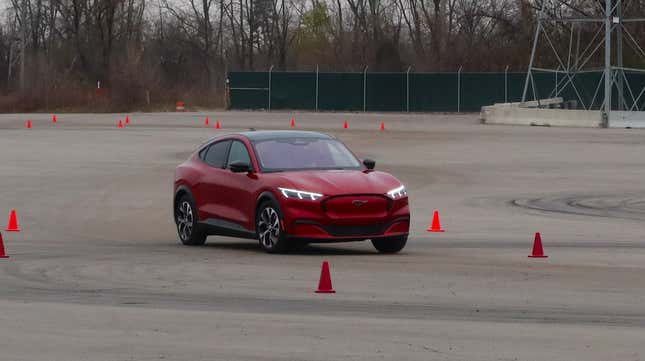
I drove the lightest Mach-E model — the standard range, rear-wheel drive car — on a small autocross course. There, the car handled tight turns well, offering plenty of grip even as the body rolled a bit. Pushing the machine too hard yielded understeer, and the stability control — which I couldn’t shut off — quickly cut in to point the car in the direction that my front wheels were pointing. I was told that turning stability control off is possible on the GT.
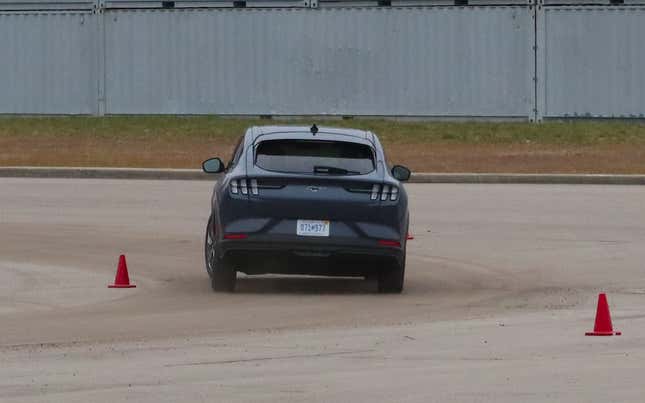
The brakes were strong, but, when not using one-pedal driving (which decelerates the vehicle hard when the driver is not on the accelerator pedal), they felt a bit different than what I’m used to. The left pedal seemed a bit too sensitive, with a light touch yielding what I felt was too much deceleration. I wonder if this is simply an issue with how Ford calibrated the pedal to blend the motor regen and friction braking. I’d need more time behind the wheel to really provide a satisfying description of what I felt, but my notes simply state “Something...off. Sensitive.” So take that for whatever it’s worth.
Here’s a short video of my autocross experience. Keep in mind that I’m a terrible track driver:
It’s not remotely as fun to drive as a V8, manual Ford Mustang, but, even with the Mach-E’s understeer, lack of sound, and brakes that felt a little... different, I enjoyed throwing the car around the autocross course. It didn’t feel unwieldy, the tires held onto the tarmac well, and the vehicle accelerated out of the turns quickly.
Early Verdict
Ford says it expects to sell 50,000 Mustang Mach-Es globally in the first year of production. Will the company reach that target? If it plans to sell most of those in the U.S., it might not be easy. Despite the vehicle being comfortable, attractive, and offering decent range for an EV — the Mach-E will face an uphill battle with buyers for two obvious reasons: Range/infrastructure concerns and pricing.

Range anxiety is real. Take a look at the image above. It shows a screenshot from Ford’s Fordpass app, which allows Mach-E drivers to identify charging locations along a route to minimize the time it takes to reach a given destination. The particular trip between Belleville, Michigan and New York City shown above would normally take about 10 hours. Because of the Mach-E’s charging time, that number jumps to 13 hours.
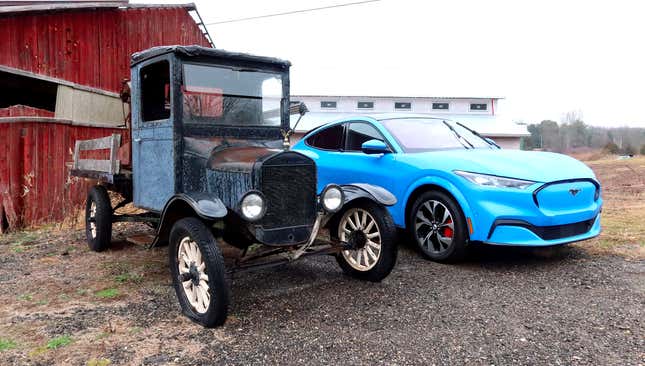
I realize that range anxiety is something that every EV detractor talks about, and to be clear, I’m an EV supporter. But the reality is that saying things like, “People just need to reframe the way they think about driving,” or even claiming, “People don’t often go on road trips, so it’s really not a big deal. Plus, they need to take breaks” just doesn’t solve the real problem. Car purchases are rarely logical. The American road trip is a romanticized concept. Whether people actually take them or not, it’ll be hard for some to imagine buying a car that isn’t at least capable of road tripping without long delays for charging. Three additional hours tacked onto a 10 hour trip is going to turn some folks away. That’s just reality. It’s going to take a strong information campaign by Ford to move customers towards this car. Mach-E pricing may be an issue as well, even though it is highly competitive among EVs, undercutting the $49,990 Tesla Model Y.
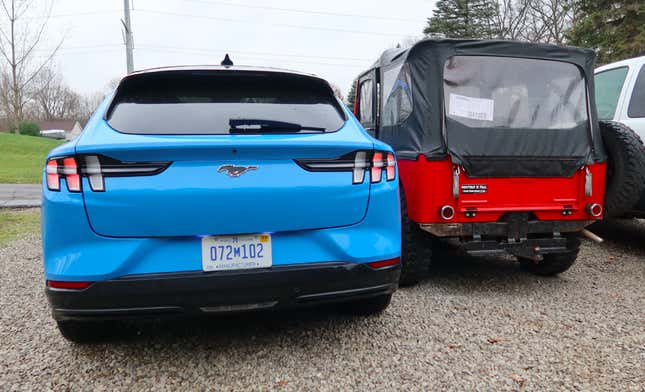
The extended range, all-wheel drive First Edition model that I drove cost roughly $60,000. Subtract the $7,500 federal tax incentive, and this Mach-E is still about the same price as a well-equipped Ford Explorer (which is much bigger) and it’s significantly pricier than a loaded-up Ford Edge. So why buy the Mach-E, especially if you road trip a lot, or if your local infrastructure is going to make EV ownership difficult for you?
I can think of many reasons, of course. EVs offer advantages in terms of maintenance since they have fewer moving parts than ICE vehicles, EVs are quiet, EV torque delivery/acceleration is unique, EVs are better for the environment, EVs are just technically cool, and on and on. But when it comes to value for the customer, these aren’t likely to be enough to sway a mass audience to plop down all that cash and deal with the drawbacks — unless that audience decides the Mach-E has a certain Tesla-like “it-factor.”
I’m left unsure if it does. We’ll see what the market thinks.
Correction Dec. 29 2 P.M. ET: The main infotainment screen is 15.5 inches, not 10.2 inches (that’s the size of the gauge cluster). Apologies for the error.
